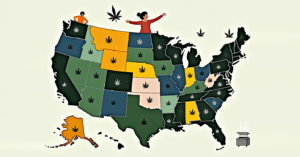Cannabis laws in the United States are changing fast. Many states now allow medical or recreational use. But federal law still bans it.
The path to federal legalization is unclear. Public support is growing, with 88% of Americans backing legal marijuana for medical or recreational use. Despite this support, federal legalization faces hurdles in Congress and from government agencies like the DEA.
Recent political shifts may change things. Both major 2024 presidential candidates have hinted at reclassifying marijuana as a less dangerous drug. This could be a step toward broader changes. The cannabis industry keeps growing, pushing for new laws. As more states legalize, pressure on the federal government may increase.
Historical Context of Cannabis Legislation
Cannabis laws in the United States have a complex history. Federal prohibition, the Controlled Substances Act, and the War on Drugs have shaped cannabis policy for decades.
Origins of Federal Prohibition
Cannabis use in America dates back to the Colonial Era. The government even encouraged hemp production in the 17th century.
But attitudes changed in the early 20th century. Many states began restricting cannabis from 1906 onward.
By the 1920s, some states had outright bans. The Marihuana Tax Act of 1937 marked the first federal regulation.
This act didn’t technically ban cannabis. But it made possession or transfer of marijuana illegal without a special tax stamp.
Controlled Substances Act and Schedule I Classification
In 1970, Congress passed the Controlled Substances Act. This law created a system for classifying drugs based on their medical use and potential for abuse.
Cannabis was placed in Schedule I. This category is for drugs with:
- No accepted medical use
- A high potential for abuse
- A lack of accepted safety for use under medical supervision
Other Schedule I drugs include heroin and LSD. This classification made cannabis illegal at the federal level.
The Drug Enforcement Administration (DEA) was created in 1973 to enforce the new drug laws.
The War on Drugs and Its Impact
President Nixon declared a “War on Drugs” in 1971. This policy increased federal funding for drug control agencies.
It also led to tougher punishments for drug offenses. Cannabis arrests and incarceration rates rose sharply.
The war on drugs disproportionately affected minority communities. It led to high incarceration rates and long-lasting social impacts.
Despite this, some states began to soften their stance. Oregon was the first to decriminalize small amounts of cannabis in 1973.
Current Federal and State Legal Landscape
Cannabis laws in the United States are complex and varied. Federal and state regulations often conflict, creating challenges for users, businesses, and law enforcement.
Dichotomy Between Federal and State Laws
Federal law classifies cannabis as a Schedule I controlled substance. This means it’s illegal to possess, use, or distribute. Yet many states have legalized cannabis for medical or recreational use.
This conflict creates legal uncertainties. State-legal cannabis businesses can’t access federal banking services. They face high taxes and limited deductions. Federal employees and contractors risk job loss for using state-legal cannabis.
Law enforcement faces challenges too. Federal agencies might raid state-legal dispensaries. State police may ignore federal laws when dealing with legal cannabis users.
Variations in State Cannabis Policies
As of 2024, 38 states allow medical marijuana. 24 states have legalized recreational use. Each state has unique rules and regulations.
Some states only allow low-THC products. Others have robust recreational markets. Possession limits, cultivation rules, and qualifying medical conditions vary widely.
Licensing and taxation differ too. Some states limit licenses, while others encourage small businesses. Tax rates range from low to over 30% in some areas.
Medical Marijuana and Federal Guidelines
Federal law doesn’t recognize medical marijuana. But the government has issued guidelines for states with medical programs.
The Cole Memorandum advised federal prosecutors not to interfere with state-legal medical marijuana. This memo was rescinded in 2018, creating uncertainty.
Doctors can’t prescribe cannabis, only recommend it. Veterans face challenges accessing medical marijuana through VA healthcare. Research on medical cannabis is limited due to federal restrictions.
Public Perception and Societal Shifts
Views on cannabis have changed dramatically in recent years. More Americans now support legalization. Social attitudes are shifting, and the COVID-19 pandemic has affected how people see cannabis use.
Surveys and Public Opinion Trends
Most Americans favor legalizing marijuana for medical or recreational use. A Pew Research Center survey found 88% of U.S. adults support some form of legal cannabis.
57% think it should be legal for both medical and recreational purposes. 32% believe it should only be legal for medical use. Just 11% say it should not be legal at all.
These numbers show a big change from past decades. Support for cannabis legalization has grown steadily since 2000.
Changing Social Attitudes Towards Cannabis Use
Social views on cannabis use have shifted greatly. Many now see it as less harmful than alcohol or tobacco.
Cannabis is the most commonly used federally illegal substance in the U.S. In 2022, about 62 million people used cannabis in the past year.
More states are legalizing cannabis. This has made it more accepted in society. People are more open about using it for medical reasons or relaxation.
The push for social justice has also changed views. Many see cannabis laws as unfair to certain groups.
Impact of COVID-19 on Cannabis Perception
The COVID-19 pandemic changed how people think about cannabis. Many states labeled cannabis businesses as “essential” during lockdowns.
This decision gave cannabis more legitimacy. It helped normalize its use in the public eye.
Stress and anxiety from the pandemic led some to try cannabis for the first time. Others used it more often to cope with isolation and uncertainty.
The pandemic also highlighted potential health benefits of cannabis. This further improved its image for many people.
Economic Implications of Legalization
Legalizing cannabis at the federal level would have major effects on the U.S. economy. It could boost tax revenue, create jobs, and change how businesses operate in the industry.
The Growth of the Cannabis Industry
The legal cannabis industry has expanded rapidly in states where it’s allowed. Sales of legal cannabis in the U.S. reached $33 billion in 2022. This number could grow even more with federal legalization.
Federal legalization would let cannabis companies work across state lines. They could ship products to other states and expand their reach. Banks would also be more willing to work with cannabis businesses.
Many big companies are getting ready to enter the market if cannabis becomes legal nationwide. Food and beverage firms are looking at cannabis-infused products. Tobacco companies are also interested in the industry.
Federal Tax Implications and Benefits
Legalizing cannabis could bring in a lot of tax money for the government. Right now, the federal government doesn’t get tax revenue from legal state cannabis sales.
A national cannabis tax could raise billions of dollars each year. This money could fund important programs or help reduce the national debt.
States that have legalized cannabis have seen big increases in tax revenue. For example, Colorado collected over $2 billion in cannabis taxes between 2014 and 2019.
Federal legalization would also make it easier for cannabis businesses to pay taxes. Currently, they face challenges with banking and tax rules.
Job Creation and Market Dynamics
The cannabis industry is already creating many jobs in states where it’s legal. Each medical marijuana store creates about 6.2 jobs on average.
Federal legalization would likely lead to more job growth across the country. New positions would open up in farming, processing, retail, and related fields.
The industry could also create opportunities in other sectors. These might include:
- Marketing and advertising
- Legal services
- Security
- Packaging and distribution
As the market grows, it could lead to more competition and innovation. This might result in better products and lower prices for consumers.
Health and Public Safety Considerations
Cannabis legalization raises important health and safety issues. Key areas of focus include medical uses, product safety, and the effects of various cannabis compounds.
Medical Applications and FDA Stance
Cannabis shows promise for treating certain medical conditions. Some studies suggest it may help with chronic pain, nausea, and epilepsy. However, the Food and Drug Administration (FDA) has only approved a few cannabis-derived medications.
The FDA requires more research to fully understand cannabis’s medical potential. This research is challenging due to federal restrictions. As a result, many doctors remain cautious about recommending cannabis.
State-level medical marijuana programs exist in many places. These programs allow patients to access cannabis for various conditions. But federal law still classifies cannabis as illegal, creating legal conflicts.
Cannabis Products and Consumer Safety
The growing cannabis market raises safety concerns. Products vary widely in quality and potency. This makes it hard for consumers to know what they’re getting.
States with legal cannabis have implemented testing requirements. These rules aim to catch contaminants like pesticides and mold. They also check THC levels to ensure accurate labeling.
But safety standards differ between states. This lack of consistency can put consumers at risk. Some experts call for federal oversight to create uniform safety rules.
THC, CBD, and Emerging Compounds
THC and CBD are the most well-known cannabis compounds. THC causes the “high” associated with marijuana use. CBD doesn’t have psychoactive effects and is used for various health purposes.
New cannabis compounds are emerging. Delta-8 THC, for example, has become popular in some areas. It’s often made from hemp, which is less regulated than marijuana.
These new compounds raise safety questions. Their effects aren’t well understood. Some may have unexpected health impacts. Experts worry about potential risks, especially for vulnerable groups.
Regulators are trying to keep up with these developments. But the rapidly changing cannabis landscape makes this challenging.
Legal Challenges and Reform Initiatives
Efforts to reform cannabis laws in the United States face complex legal and political hurdles. Several initiatives and bills have been proposed at the federal level, but progress remains slow. The path to nationwide legalization is complicated by varying state laws and conflicting federal policies.
Recent Legalization Efforts and Bills
The MORE Act (Marijuana Opportunity Reinvestment and Expungement Act) aimed to decriminalize cannabis at the federal level. It passed the House in 2020 but stalled in the Senate.
Another significant proposal is the Cannabis Administration and Opportunity Act. This bill seeks to remove marijuana from the Controlled Substances Act and establish a federal regulatory framework.
State-level initiatives continue to advance. In 2024, several states including Florida, North Dakota, and Nebraska are considering ballot measures to legalize recreational or medical marijuana use.
Federal Legalization Prospects and Challenges
Federal cannabis reform faces several obstacles:
- Political divisions in Congress
- Concerns about public health and safety
- Conflicting state and federal laws
- Opposition from some law enforcement groups
Despite these challenges, public support for legalization has reached record highs. As of 2024, 70% of Americans believe marijuana should be legal.
The growing number of states with legal cannabis markets puts pressure on the federal government to act. However, the complex process of aligning state and federal laws remains a significant hurdle.
Potential Models for Federal Cannabis Regulation
If federal legalization occurs, several regulatory models could be implemented:
- State-based approach: Allow states to regulate cannabis within federal guidelines.
- Federal oversight: Create a new agency to regulate cannabis similar to alcohol or tobacco.
- Hybrid model: Combine federal standards with state-level implementation.
Key issues to address in any regulatory framework include:
- Taxation and revenue allocation
- Criminal justice reform and expungement of past convictions
- Product safety and labeling standards
- Interstate commerce regulations
The current policy gap between state and federal laws complicates the development of a unified regulatory system. Bridging this gap will be crucial for creating an effective national cannabis policy.
Social Equity and Criminal Justice
Cannabis legalization efforts in the U.S. have highlighted long-standing issues of inequality and injustice. These efforts aim to address past harms and create new opportunities for those most impacted by marijuana prohibition.
Injustices and Disparities in Marijuana Policy
Marijuana laws have disproportionately affected minority communities. Black Americans are nearly four times more likely to be arrested for marijuana possession than white Americans, despite similar usage rates.
This disparity has led to long-lasting consequences for individuals and families. Criminal records can limit job prospects, housing options, and educational opportunities.
Some states have begun to address these issues through targeted programs. These initiatives aim to give those most affected by marijuana prohibition a chance to benefit from the new legal industry.
Restorative Justice and Decriminalization
Decriminalization efforts seek to reduce or eliminate criminal penalties for marijuana possession. This approach can help prevent new arrests and convictions.
Many advocates push for expungement of past marijuana convictions. Clearing these records can remove barriers to employment and housing.
Some states have created social equity programs as part of their legalization efforts. These programs often include:
- Job training in the cannabis industry
- Loans or grants for cannabis businesses
- Priority licensing for those affected by past marijuana laws
Future of Drug Testing and Employment
As marijuana legalization spreads, workplace drug testing policies are evolving. Some companies have stopped testing for marijuana, especially in states where it’s legal.
This shift raises questions about fairness and safety. Employers must balance workplace safety concerns with changing social norms and laws.
Some industries, like transportation and healthcare, still require drug testing due to federal regulations. This creates a complex landscape for workers and employers to navigate.
Potential Roadblocks to Federal Legalization
Federal cannabis legalization faces several obstacles in the United States. These include political challenges, complex regulatory issues, and the current administration’s stance.
Political Hurdles and Senate Opposition
Senate opposition remains a key barrier to federal cannabis legalization. Many senators, particularly from conservative states, continue to resist efforts to change marijuana’s legal status.
This resistance stems from concerns about public health, youth access, and potential increases in drug use. Some senators worry that legalization could lead to more impaired driving and workplace accidents.
Political divisions also play a role. While some Senate Democrats support legalization, others remain cautious. Republican senators generally oppose federal legalization, creating a challenging path forward in a closely divided Senate.
Regulatory Framework Complexity
Creating a comprehensive regulatory framework for legal cannabis presents significant challenges. The process involves multiple federal agencies and requires addressing various complex issues.
These issues include:
- Establishing quality control and safety standards
- Determining appropriate taxation levels
- Creating licensing and distribution systems
- Addressing interstate commerce regulations
The Drug Enforcement Administration (DEA) plays a central role in this process. Their current classification of marijuana as a Schedule I drug complicates efforts to create a new regulatory structure.
Balancing federal regulations with existing state laws adds another layer of complexity. This includes reconciling differences in state-level marijuana policies and ensuring a smooth transition to a federal system.
Current Administration’s Approach
The Biden administration’s approach to cannabis legalization has been cautious. While President Biden supports decriminalization and rescheduling marijuana, he has not pushed for full federal legalization.
The administration has taken steps to review marijuana’s drug classification. In 2024, efforts to reschedule cannabis as a less dangerous drug gained momentum. This move could ease research restrictions and potentially lead to broader reforms.
However, the administration faces pressure from both pro-legalization advocates and opponents. Balancing these competing interests while addressing public health and safety concerns remains a challenge for federal policymakers.
Join the CalmEffect Insider Club
Get exclusive access to insider-only deals, groundbreaking news, and expert guides right in your inbox.







